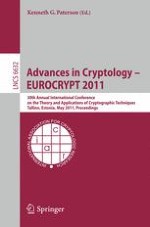This book constitutes the refereed proceedings of the 30th Annual International Conference on the Theory and Applications of Cryptographic Techniques, EUROCRYPT 2011, held in Tallinn, Estonia, in May 2011. The 31 papers, presented together with 2 invited talks, were carefully reviewed and selected from 167 submissions. The papers are organized in topical sections on lattice-base cryptography, implementation and side channels, homomorphic cryptography, signature schemes, information-theoretic cryptography, symmetric key cryptography, attacks and algorithms, secure computation, composability, key dependent message security, and public key encryption.
